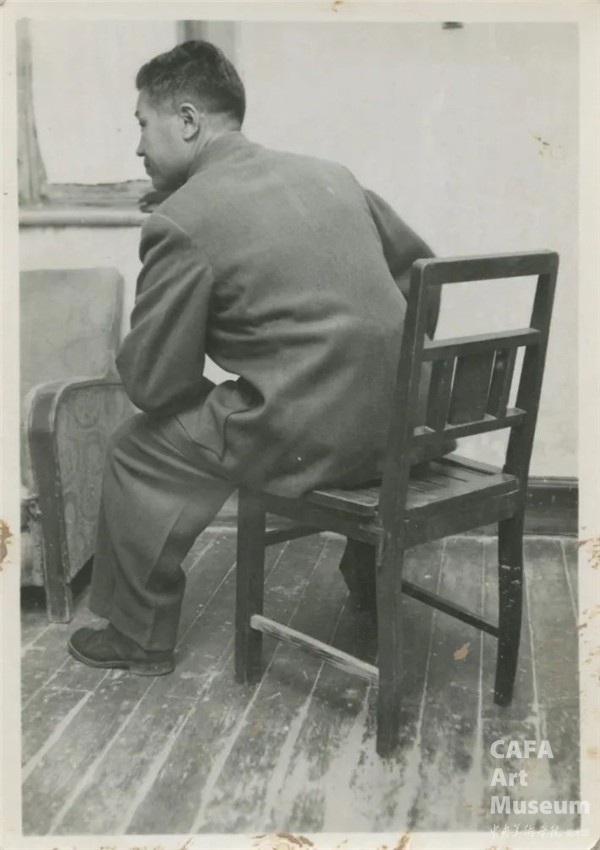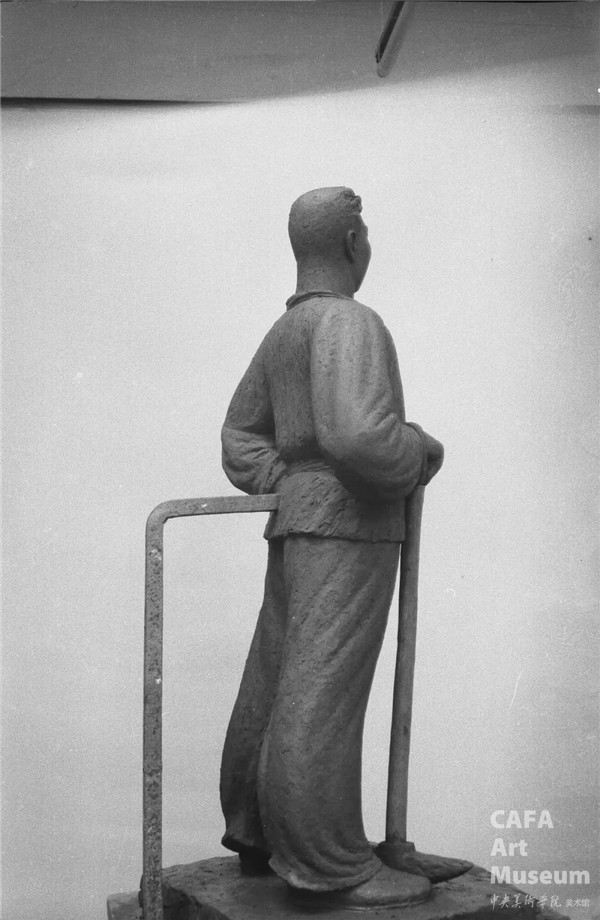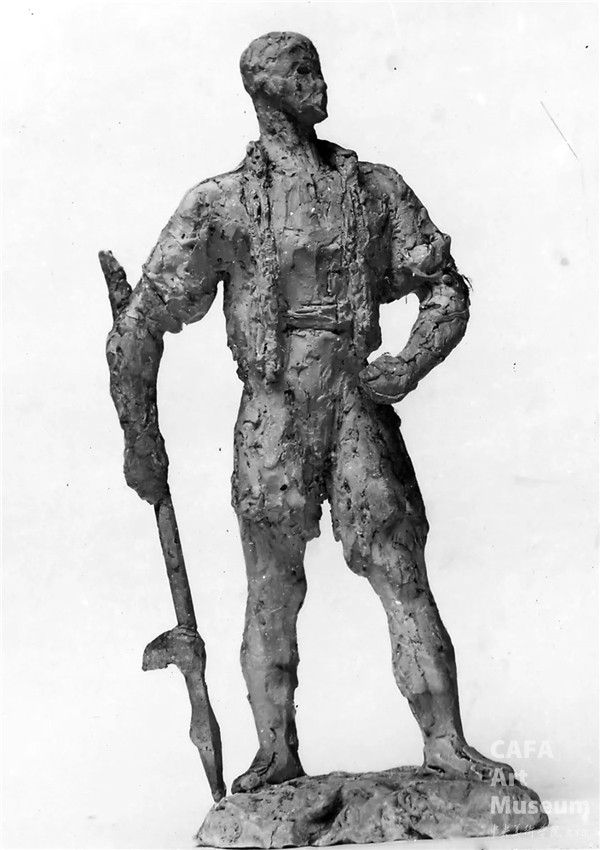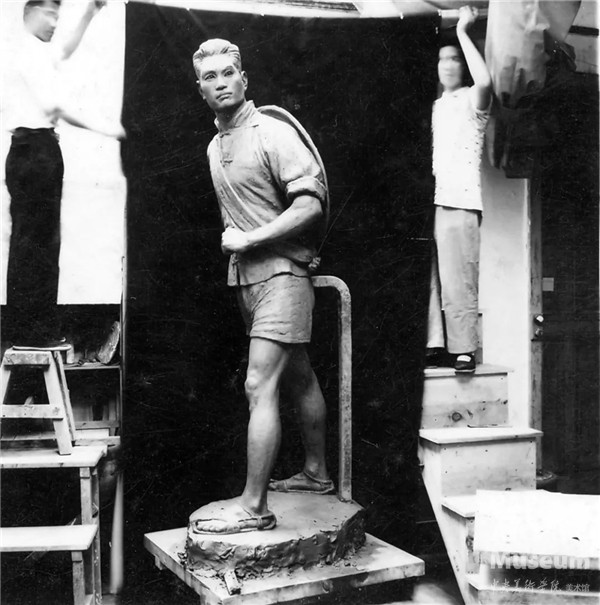
滑田友先生是20世纪中国雕塑发展史上具有深远影响的艺术家,他不仅是新中国雕塑艺术乃至新中国美术的标杆,更是在几十年的教育教学生涯中,为中央美术学院的雕塑教学,为雕塑系的发展壮大投入巨大心力。“勿失毋忘——雕塑家滑田友诞辰120周年纪念展”展览的“教学方法论——滑田友的教学笔记与方法传授编”单元,以滑田友本人为模特儿摆动作抓造型的系列留影、单件作品在完成过程中的系列留影以及滑田友教学笔记与文章发表为中心,结合场刊文字以及中央美术学院雕塑系教具的提示与辅助,展现滑田友钻研教学和提炼经验并形成六法、贯气、编筐、串冰糖葫芦、铺石子路、看山、八根线、一段段的好风景等独具眼光和魅力的个人教学语言。现将滑田友于1956年关于教学的撰文《我对雕塑基本训练的看法》刊发如下。

1959年雕塑系教师合影。右起王鸿文、钱绍武、王临乙、王合内、于津源、滑田友、刘开渠、王克庆、范文龙、刘小岑、曾竹韶。滑田友家属提供
(一)
雕塑家要做好创作首先必须有思想性,没有思想性就没有灵魂。但要表现思想性,又必须能把人的形象做出来,思想性才有寄付。要把人的形象做出来又必须具有人的造型的基本知识,逐步掌握人的形成的规律,才能在创作中得心应手。不然所做的作品就会辞不达意,叫人感到缺憾、落空。有了思想性又能准确的用人的形象表达出来,是不是就完成了雕塑家的能事了呢?还没有。那样的作品也只能供人知道这是说明什么事情一看而过,而不能耐寻味,留恋不忍去。如果要达到耐人寻味,还得精心考虑,如何巧妙安排的技巧,如何提高的艺术性。所以在学习雕塑创作的过程中,既要研究思想性,又要研究造型的基本知识,又要研究如何巧妙安排的艺术性,使三者结合才能做出好的作品来。基本训练就是创作必须知道的人的造型的基本知识。研究前人已经得到的造型规律和进行尝试运用巧妙安排的经验(研究艺术性的),而且进行逐步的专门训练。为着循序渐进,也和认识一般事物一样由基础到提高,由感性认识到理性认识,由理性认识到运用。也就是由基本知识到掌握规律,运用规律,提高到艺术性。

滑田友在中央美术学院雕塑系教学 滑田友家属提供
(二)
做人体的基本知识是什么?有三:
1. 运动规律:平常一个人看见另一个人,在刹那之间,首先感觉到的就是一个人,男人或女人,静止或运动,或者是喜怒哀乐某一种感情和行、走、坐、卧某一种动作所形成的综合概念,也就是有表情的活动着的人。而很少去研究对面的人的思想感情是怎样形成的。一个雕塑家或学雕塑的学生就不然。他们会不自觉的去注意到这些。而且进行长期的逐步的训练。
以便达到在他们所做的作品上更生动,能够解说出人在行动时,身体上究竟起了什么样的变化,什么在起某一动作或某一感情的作用?比如一个人站着,如何站就站得稳?如何就站不稳?行走的人是不是真像在走着?像不像在做那件事?关键究竟在什么地方?实际就在重心的位置正确不正确?人身体各部如中心线,轮廓线,全身各处动作的形势,各部分形体的正面(主要面)和转折面是不是都适应了这个动作?两眼、两肩、两胯骨所形成各横线以致各方面肌肉变化(解剖学)是不是都适应了这个动作?适应动作的趋势?重心对了,各部都适应了动作的趋势了,就像,看得就舒服。不适应了,就不像,也就不舒服。



《五四运动宣传者(男站立像)》创作照 1962年 滑田友家属提供
同样如果要问:人的喜、怒、哀、乐、俯、仰、顾、盼的各种表情中,头部、脸部、口和眼睛究竟怎样变化和究竟怎样一致的关键究竟在什么地方?那么可以这样举例来解答:比如一个人脸在平静的时候,各方面皆是一致的平静不动的,但在笑的时候,面部肌肉就在向外开展了,开展的程度如何,正可以说明他笑的程度如何?当人哭的时候,脸部肌肉全在向内收敛,敛的程度如何?也正足以说明他在大哭或者在悲哀。同样愤怒和忧愁,气氛和同意之类,面部又怎样变化?也可以作不同的各方面研究。能认识到这些问题,也就是研究的一个阶段。能找到这些关键和能正确的作出富有思想感情的作品来。而且又各有各的不同程度的阶段。总之,没有严格的训练,就不能逐步认识和找着这些关键,做出好的作品来。因此可以说找着动作的规律,就是塑造思想感情的基础。

1977年滑田友在中央美术学院雕塑系教学 滑田友家属提供
2. 组织规律:在一个人看另一个人,而且他已知道他的行动和表情之后,往往就会马上去辨别他是男人女人?是长是短?是农民是工人?或是知识分子?是张三是李四?是美是丑?其他往往不甚注意作为一个雕塑家来说就有些不一样,因为雕塑家看人,第一眼可能和一般人一样,但再看就会不知不觉去分析那个人,就会研究人的运动规律,内部和外部组织规律,以及除由于人的先天赋予的男性女性,长短高矮之外,还会去分析这个人的思想感情,研究这人的性格和特征,会研究一系列的这儿不同和那些分别,如何不同,为什么不同之类的问题。如:
①比例问题:人的男女长短一般来说是有一定比例的,如头和全身是1比7,人的中心点是在耻骨的中间。中国画论里也有盘三坐五行六立七和三停五部之类歌诀皆是一般规律。
②组织关键:人的头部、胸部、臀部都是比较固定形状的。而颈、腰和各关节又是经常可以活动的,但又因他们经常活动又有一定的规律。所以就都成为一般规律。




滑田友示范衣褶效果 滑田友家属提供
③型:人的面形还可以分为好些类型,如说“面如古月”又说“瓜子脸”“长方脸”“龙长脸”和国画理论中的田、由、国、用、目、甲、申、风之类的应物象形的脸形。皆是指人的头部的整体而言。因为这些类型也由于每一个类型同样的人数很多,也可以作为一般规律。
④组成:还可以看出人的头部(以及各部)不仅仅外部总的形状可以这样形容,而这种形体实际在其总形以内还可以分析为两个形或三个形组合起来的组合体。那就更能说明特点,而且不独头部如此,胸部、腹部、四肢各部都可以看出是各种各样的组合体组合而成。而且每一个形和另一个形之间交接处皆有过渡阶段和过渡的变化。不独形是组合的,而每个形皆是面所组合的。而且每一个面与另一个面的交接处同样也有转折面的变化。这实际也可以作为一般规律。

女生产队长 铸铜 50×33.5×26cm 1961 中央美术学院美术馆藏
⑤典型:另外有比较正常规律稍大一点的,但大得得体,合乎某一类人的特点,因为那特点是由于他本人职业、生活、劳动、思想感情所形成的。那就更帮助人去注意这类人的思想感情的规律,那就叫“典型”。比如劳动人民,如工人或农民的手就与一般人不同,又如一个游泳选手,他的胸部比一般人扩张较大。一个举重力士又有某一部分与人不同。而各行各业的偏重发达皆说明典型。所以人一看就知是工人农民或知识分子,不同的关键就在于人的各种不同的外形。人的各种不同的生活,会影响人的形象偏重的发达。甚至其组织排列比例皆随其职业而变化了。

《红色游击队员》创作照 1957年 曾陈列于中国人民革命军事博物馆 滑田友家属提供
⑥面痕:不独形体上起了变化,外形还会留下痕迹。比如农民生活比较单纯朴素一点,他们的面上活动痕迹就显现出来少一点,工人生活变化复杂一点,他们的面痕可能就多了一点。实际各种各样的人都有他不同的面痕。而显示出不同的职业来。
⑦特点:另外有的不应当大的大了,如一个女人脸型下部太大,或者下部太长太宽,或者眼睛太小,或者颧骨离奇就显出丑来。相反有的眼睛较大,下巴较尖或者没有什么奇形凸出,到处匀称可能就美。因为由于经过很多人数的对比所得的结论,也就可以作为一般规律。

1977年滑田友在中央美术学院雕塑系教学 滑田友家属提供
⑧自然:如果一个雕塑家能做到他的作品使人一目了然的很舒服,不发生什么比例动作等等问题,那就很容易使人直接去看到思想感情上去,这就叫正确,或者准确,也叫掌握了规律。也就可以算好。但一般初学的人往往不能做到这一点。不能做到还不要紧,往往又因为错误而感到丑。
⑨变形:另外能力很强的雕塑家,可以得心应手,他可以把原来天生丑的改动一下改为美的,那是他已经知道什么叫丑。什么美,和怎样做就美,或者就典型。而这些皆要看训练如何。总之组成规律的的认识和掌握也就是建立性格和特征的基础。

滑田友在中央美术学院雕塑系教学 滑田友家属提供
3. 艺术技巧的训练:美术学院雕塑系的学生首先训练的是要认识一般规律和掌握这些规律是必要的。但这还不是最后的目的,还不止于认识和掌握规律而在于用规律创造新的形象。认识规律掌握规律,只能描写现实,而尚不能歌颂或批判现实。歌颂或批判现实要能知道什么样就互相矛盾,什么样就互相联系互相调和,什么样就不调和,怎样又可以调和,怎样可以把互相矛盾转化为统一,怎样就有节奏和丘壑。要能知道既适应思想又适应眼睛。要懂得什么叫雕塑的语言,要能突破常规进行创造。所以要能歌颂或批判现实,就要知道如何加以整理,加以提炼,加以简化和加以夸张。

1959年滑田友创作《空军英雄头像》 滑田友家属提供
提高阶段不但不怕重复而且必须重复以前的锻炼。而在熟练的程度上加以提高。逐步突出以韵律和节奏来表现主题的典型性格和典型环境。要突出重点,突出中心,要有丘壑要有虚实,要知道乘势夸张乘势创造。要能综合运用,一气呵成。要达到想秀丽就秀丽,想古拙就古拙,既含蓄又奔放的境地,这才达到得心应手。
为着逐步训练,我把各年级学习步骤以表格的形式写在下边:
步骤表
本表是一件雕塑作品各阶段的逐步要求。可以在一个步骤完成之后,马上就进行第二个步骤的一步一步作下去。每一步骤的时间可以长一点,也可以短一点,主要要看熟练的程度如何。因此每一步骤可以在一个月之内完成(如大型雕塑)。也可以在一周之内完成,也可以在一天或一小时之内完成。而且每一步骤完成之后就可以马上转入下一个步骤。而且可以巡回反复地作下去。但是为着学生学习方便,认识清楚和打下稳固地基础也可以分为各年级分阶段的逐步训练。如一年级学做人的头像,二年级学做人的全身,皆可以只学第一步的基本知识,三年级则在二年所学的基本知识之上,进行第二步的研究,四年级又在前三年所学的基础上,做更进一步的研究,五年级就再进一步深入研究(全面地研究)。

滑田友规划的雕塑系各年级学习步骤表
(三)
1. 学习研究雕塑的基本训练,也像处理一件大事一样或一个战疫一样,既要从实际出发,又要始终虚心,全心全意,思想既不开小差又不抱想,只有忠实客观实际才能不断发现和不断提高。
2. 学习初步时了解自然,认识自然;追求自然的规律,使用自然的规律。由于规律是客观存在和认识程度不同,角度不同,就形成各人有各人的差别,而不是风格,所以一二年级时不怕不同也不怕相同。
3. 在研究过程中应当逐步的同时研究古今中外名作,去学习前人已得的经验和他们所发现的规律证实自己所得是否正确?或有更多的收获。
4. 同时也可以观察自然对证规律,再找规律。
5. 认识了规律掌握了规律以后,各人在创作中就可以发挥各人的才能,巧妙的使用,才产生风格。
6. 由一种规律的深入研究,再推而研究各种规律。

《中国人民站起来了》创作照 1962年 滑田友家属提供




《中国人民站起来了》创作照 1962年 滑田友家属提供
(四)
1. 首先是注意大体,然后才深入细部,最后又注意细部和大体结合。但最好能始终保持新鲜的感觉,也就是每天初开始工作时检查一下最初的感觉,最后目的在于能够作清楚的忆塑。
2. 应当写生和临摹相配合,观察、速塑、长期写生、默塑配套成龙,就如速塑可以在每一个大单元写生之先作为肯定新鲜感觉而用,默塑在大单元之后,作为肯定收获之用。而临摹又可以安排在总结以前经验和更进一步提高的两个阶段之间,作为开辟新阶段启发之用。
3.分单元训练,小单元和大单元配合。第一单元时较短专门学习大体,第二单元时间较长可以比较快点,把第一单元所需用的时间压缩在本单元之内,以便把较长的时间用作再多积累经验,第三单元可以更长点,再进一步积累经验,然后可以再返回来再逐步加快加长,以便提高,而不是平均对待。
4.分阶段训练:如一年级做人的头像比较多些,作为重点,第二年或第一年末了就由头像转到半身而至全身,不怕重复,需要巡回反复的逐渐发展的训练。
5.低年级(一二三年级)学习基础,高年级在原基础上逐渐提高到艺术性,最后再作灵活运用混为一体的得心应手的训练。
6.在研究艺术技巧的阶段,是可短期也可长期的阶段,因为学生学习进程和领会的程度各有不同的,尤其在五年之中积累下来,就会一班之中参差不齐。因此毕业生程度只能订成两个标准,高标准当然是能够全程学完,最低标准最好也要能够懂得,以便在毕业后继续自己锻炼。
7.从圆中找方,再从方中着圆,先方后圆,再方再圆。
8.速写记新鲜感觉,素描深入追求。
9.转的时间,先快后慢,适实需要。
10.摆的距离,要远近合适。
11.转台必须水平,骨架必须稳固准确,准备工作必须事先做好。
12.工具要能适应需要,随时自己制造,并且制的要美要好。




《红色游击队员》创作照 1957年 曾陈列于中国人民革命军事博物馆 滑田友家属提供
《我对雕塑基本训练的看法》写于1956年,油印本展出于“勿失毋忘——雕塑家滑田友诞辰120周年纪念展”。此文曾被收录入《中央美术学院建校80周年:穿越时空——雕塑系历任教师论文选集》(人民美术出版社,1998年)。
展览信息

百年辉煌•中央美术学院艺术名家
勿失毋忘
——雕塑家滑田友诞辰120周年纪念展
展览时间:2021年11月24日—12月26日
展览地点:中央美术学院美术馆二层B展厅
主办:中央美术学院
承办:中央美术学院党委宣传部、中央美术学院美术馆、中央美术学院雕塑系
总策划:高洪 范迪安
学术主持:苏新平
项目策划:秦建平
策展人:曹庆晖
展览总监:张伟 张子康 韩文超
展览统筹:王春辰 高高
特别支持:滑夏 滑玉
策展助理:易玥 李展
显示设备支持:BOE画屏
| 温馨提示 |
因校园疫情防控要求,美术馆暂停对外开放
校内师生可正常参观
